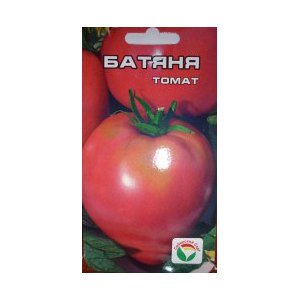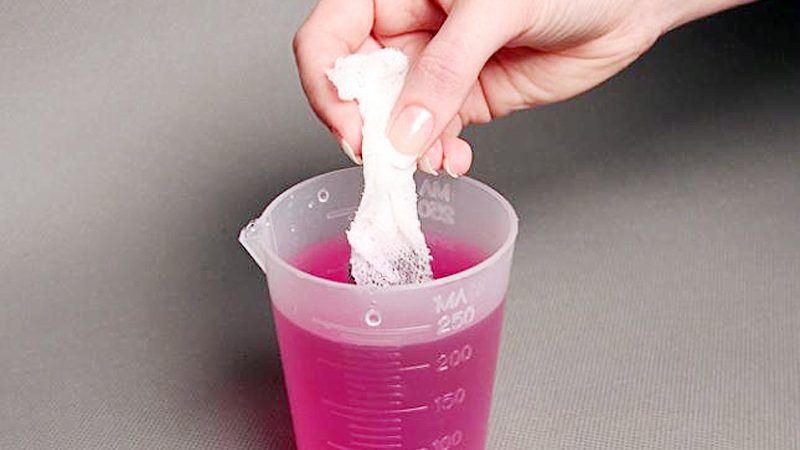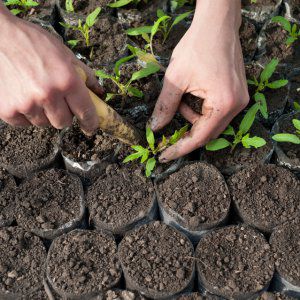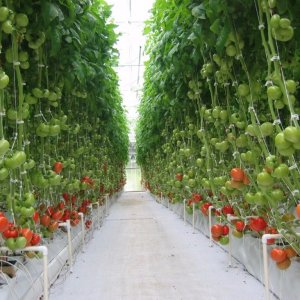Classic heart-shaped pink tomato "Batyanya": reviews and photos of the resulting crop of tomatoes
The variety was bred by Siberian breeders. Tomato Batianya is distinguished by its endurance and unpretentiousness. It can grow in the northern region and in the south. Suitable for growing in greenhouses and open field.
The content of the article
Description of the variety
Batyanya is an early ripening variety. The ripening period lasts 95-105 days. Bushes indeterminate (tall), reach 1.7-2.2 m. The stems are long, which is why the plant needs a garter. Up to 10 flowers are tied on the bush, of which 6 fruits are formed. The leaves are large, dark olive colored.
Distinctive features
 A feature of the variety is the size of the fruit. Their average weight is 300 g. Tomatoes weighing 150-200 g ripen on the clusters located in the upper part of the bush, and fruits of 500-700 g are formed on the lower ones.
A feature of the variety is the size of the fruit. Their average weight is 300 g. Tomatoes weighing 150-200 g ripen on the clusters located in the upper part of the bush, and fruits of 500-700 g are formed on the lower ones.
Fruit characteristics and yield
Fruits are heart-shaped, cone-shaped... When ripe, they acquire a pink color with a raspberry tint. Near the stalk, the skin is glossy, rather dense, but not hard. Thanks to this, tomatoes do not crack and tolerate transportation well.
The seed chambers are small. The pulp is fleshy, juicy and sugary. According to the tasting scale, the fruits of Batian are rated at 4 points. The yield is high. 3-6 fruits are formed on the hand. The productivity of one bush is 4-5 kg of tomatoes.
How to grow seedlings
To get high-quality seedlings, you must adhere to the rules of agricultural technology.
Seed preparation
The preparation of planting material is carried out to accelerate the germination of seedlings and increase the resistance of tomatoes to diseases. This helps to increase yields. The preparation consists of several stages.
Sorting
Heavy and large seeds are selected for planting. They contain a large amount of nutrients that are required for plant formation. The seeds are poured into a solution prepared from 200 ml of water and 1 tsp. table salt. Then they stir for 2-3 minutes and stand for 10 minutes.
Only those seeds that have sunk to the bottom are suitable for planting. They are washed with clean water and dried in a dark room. It is impossible to place planting material near heating devices. The seeds that float to the surface are thrown away.
Heat treatment
Heating increases the germination of the planting material. The easiest way is to use an incandescent lamp.... The seeds are kept under it for 3-5 hours. You can put them in a gauze bag and put them on the battery 2-3 days before planting. Also, the seeds are heated for 2-3 hours in an oven preheated to 50-60˚С.
Disinfection
This step helps protect tomatoes from disease. The seeds are soaked for 20 minutes in a 1% potassium manganese solution. But first they need to be filled with water for a day. After potassium permanganate processing the planting material must be washed. For etching, a 3% solution of hydrogen peroxide, heated to 40 ° C, is also used. The seeds are kept in it for 7-8 minutes. Then they need to be dried.

Etching is also carried out dry using a fungicide. For example, Fundazole, which is mixed with seeds. For 1 kg of planting material, 5 g of fungicide are used.Wet disinfection is performed five days before disembarkation, dry - two days.
Nutrient treatment
The day before planting, the seeds are placed in a solution of nutrients:
- Epin (1-2 drops per 100 ml of water);
- Virtan-Micro (10 g per 1 l);
- Immunocytophyte (1 tablet per 150 ml);
- sodium humate (1 g per 2 l);
- potassium humate (50 ml per 10 l).
The water for the solutions is heated to 45 ° C.
Soak
This procedure is optional. But it allows you to get seedlings 2-3 days earlier and increase the resistance of seeds to cold soil. They are placed in a gauze bag and kept in water at a temperature of 25-30˚C for 12 hours. After that, the planting material is dried. The water is changed every 4-5 hours.
Germination
To accelerate germination and get an early harvest, the seeds are germinated. A cotton cloth is placed in a plate and poured over with warm water. Seeds are poured on top. Then they are covered with moistened gauze or cloth and placed in a room with a temperature of 20-25˚С.
Hardening
Hardened seeds are highly resistant to adverse weather conditions. They need to be placed between two layers of cloth or gauze, filled with warm water and placed on the battery. They should swell after 3 days. Then the planting material is placed in the refrigerator for 20 hours, after which it is kept in a warm room at 20˚С for 6 hours. The procedure is repeated within a week.
Bubbling
You will need an aquarium compressor and a can for this procedure. The container is filled with water at a temperature of 20 ° C, a hose is fixed at the bottom through which air is supplied. The seeds are placed in a jar for 12 hours. This helps oxygenate them. Then the seeds are dried so that they crumble.
Capacity and soil
For seedlings, you need to prepare boxes, pots or plastic cups at least 10 cm high. The soil mixture can be purchased at the store. It should be mixed with garden soil in a 1: 1 ratio and add chalk or dolomite flour (2 tablespoons per 10 liters). The basis of store mixes is peat. It is poorly permeable to moisture and has a high level of acidity.
Many gardeners prefer to make the substrate themselves. Several mixtures are suitable for tomato seedlings:
- Sod land, peat and humus mix in equal amounts, add 1 tsp to a bucket of mixture. urea, 1 tbsp. l. potassium sulfate, 3 tbsp. l. superphosphate and 1.5 tbsp. l. ash;
- 0.5 part mullein, 1 part sawdust and 3 parts peat or 1 part sod land, 4 parts peat and 0.25 parts mullein, mix, add 1 g of potassium chloride, 2 g of superphosphate, 10 g of ammonium nitrate and 3 kg to a bucket of soil river sand;
- mix 1 part of soil and compost, 2 parts of peat, add 10 g of potassium and urea, 30 g of superphosphate and 200 g of ash to the bucket of the mixture.
The soil for the substrate cannot be taken from the area where tomatoes, peppers, potatoes or eggplants grew. The soil is preliminarily disinfected to destroy pathogenic microorganisms. It is poured with boiling water, then laid out on a baking sheet in a layer of 5 cm and sent to the oven, preheated to 90 ° C for 30 minutes. For disinfection, the soil is also placed in a freezer for 5 days, then kept warm for a week and again exposed to cold.
Sowing
First, drainage material is poured into the container with a layer of 1.5 cm. For this, expanded clay, sand or fine gravel are suitable. Then the box or pot is filled with soil and grooves are made in it with a depth of 1 cm at a distance of 3-4 cm. The seeds are placed every 1-2 cm. The grooves are sprinkled with earth. Deepening can be omitted. The planting material is laid out on the surface and covered with a layer of earth 1 cm thick.
 The seeds require 80-90% moisture. To provide the necessary microclimate, they are covered with glass or film, which is removed after 2 weeks. The containers are placed in a room with a temperature of 20-30˚С. At 20-25 ° C, the sprouts will sprout in 5-6 days. If the room is 25-30˚C, this process will take 3-4 days. Seedlings will appear at 10˚C, but this will take 2 weeks.
The seeds require 80-90% moisture. To provide the necessary microclimate, they are covered with glass or film, which is removed after 2 weeks. The containers are placed in a room with a temperature of 20-30˚С. At 20-25 ° C, the sprouts will sprout in 5-6 days. If the room is 25-30˚C, this process will take 3-4 days. Seedlings will appear at 10˚C, but this will take 2 weeks.
Growing and care
When the sprouts appear, the container is transferred for 7 days to a place with a temperature of 10 ° C at night and 12-15 ° C during the day. Then the seedlings are moved back to a warm room. This is necessary to prevent strong stretching of the plants.
The seedlings are watered with warm water at a temperature of 22-25˚C, which is preliminarily defended for 12 hours. For this, a spray bottle is used. Cold water cannot be used, this will lead to the development of root rot and black leg.
The regularity of watering is determined by the condition of the soil. It shouldn't dry out. But also, excessive moisture of the substrate should not be allowed. Plants are watered under the stem. This can be done with a syringe without a needle.
In order for the sprouts to receive enough light, the container is placed on the windowsill from the southwest or south side. If this is not possible, you need to illuminate the plants with lamps for 16 hours a day. After 10-18 days, when the sprouts have 2 leaves each, you need to dive. Each plant is transferred to a 200 ml container. The soil is first watered abundantly, after which the sprouts are dug out with a dive peg or a teaspoon and transplanted together with an earthen lump.
Some gardeners trim 1/3 of the center root. But other vegetable growers consider this an unnecessary procedure. Damaged plants will take a week to recover. After 15-20 days, a re-pick is performed. The seedlings are transferred to 1 liter pots.
After the first pick, the plants are fed. To prepare the mixture you will need:
- 10 liters of water;
- 10 g of potassium salt;
- 40 g superphosphate;
- 8-10 g of ammonium nitrate.
After 8-10 days, tomatoes are fertilized a second time with a solution of the following components:
- 10 liters of water;
- 20 g of potassium chloride;
- 15 g of ammonium nitrate;
- 70 g superphosphate.
Chicken droppings can be used. It is diluted with water in a 1:10 ratio. 60 g of superphosphate is added to 10 liters of the composition. 2-3 days before moving seedlings into open ground, carry out the third top dressing. To do this, apply:
- 60 g of potassium chloride;
- 40 g superphosphate;
- 10 g of ammonium nitrate;
- 10 liters of water.
4-5 days before disembarkation, they begin to harden the seedlings. The containers are taken out onto the street or balcony for 2-3 hours. Then the hardening is prolonged. Tomatoes are kept outdoors for 6-8 hours. Lower temperatures, exposure to wind and sun help seedlings to adapt to growing in open ground.
How to grow tomatoes
Proper care will increase yields.
Landing
For tomatoes, choose a well-lit place. Do not use the area where eggplants, cabbage, peppers were grown. The precursors of tomatoes can be legumes, cabbage, corn, and cucumbers.
In the fall, the soil is dug up and 7 kg of humus, 700 g of lime and 40 superphosphate per 1 sq. m. In the spring, the soil also needs preparation. The land must be re-dug up and added to 1 sq. m 20 g of superphosphate.
Planting begins in the second half of May. In open ground, you can move plants that have reached a height of 25-35 cm, in which 8-10 leaves have formed. Tomatoes are planted in holes 15 cm deep, which are placed every 40 cm. 50 cm are left between the rows. The plant is placed in a hole, watered with 1.5-2 liters of water and sprinkled with earth.
Care
Tomatoes need regular watering... At the flowering stage, 1 sq. m spend 20-30 liters, when forming ovaries - 40-50 liters, when ripening fruits - 70-80 liters. After watering, the soil under the tomatoes must be loosened. This will allow air to reach the roots. In the first 3-4 weeks, the soil is loosened to a depth of 10 cm, then by 15-16 cm. The procedure is carried out every 2 weeks. Loosening is combined with weeding, which involves removing weeds.
Hilling is performed 15-20 days after planting. The earth is raked to the bottom of the bush. After 2 weeks, the procedure is repeated. Tomatoes of the Batianya variety are formed into 1-2 stems. Excess lateral branches, which are called stepchildren, are removed when they reach 5-10 cm. In this case, a 1 cm stump should be left.This will prevent the appearance of the stepson in the future. Such branches thicken the planting, which leads to lower yields and increases the likelihood of the spread of fungal diseases.
 Tomatoes need to be tied up. For this, stakes with a height of 1.5 to 1.7 m are installed between the rows after 3 m.A twine is pulled at a distance of 30 cm from the ground. The ends are tied to stakes. As the plants grow, another 3-4 levels of twine are pulled. Deviated stems and brushes with fruits are tied to it.
Tomatoes need to be tied up. For this, stakes with a height of 1.5 to 1.7 m are installed between the rows after 3 m.A twine is pulled at a distance of 30 cm from the ground. The ends are tied to stakes. As the plants grow, another 3-4 levels of twine are pulled. Deviated stems and brushes with fruits are tied to it.
Tomatoes are fed 14 days after planting. For 1 sq. m of soil, 20-35 g of potassium salt and superphosphate, 10 g of nitrophoska, 15 g of urea and 10 g of nitrate are added. The second time the tomatoes are fertilized after 20-25 days with the same substances.
To improve air exchange and provide plants with sufficient light, excess leaves must be removed.... The first procedure is carried out 1.5 months after planting. Subsequently, it is repeated once a week. From each bush, 3 lower leaves are removed, as well as all yellowed leaves.
Features of cultivation and possible difficulties
It is necessary to plant seeds of the Batianya variety for seedlings 2 months before planting in a garden or greenhouse. If this is done ahead of time, the tomatoes will lose the first clusters on which the largest fruits ripen.
Bushes need support. Without a garter, they will break under their own weight.
Diseases and pests
Batyanya is an early variety. This prevents late blight of tomatoes from infestation, which develops in late summer in hot and humid weather. These tomatoes can be affected by Fusarium, Vercillosis or Alternaria. And also be exposed to pests:
- beetle larvae;
- wireworm;
- aphids;
- bear;
- scoops;
- whitefly.
Irrigation at the stage of ripening with a special infusion will help protect tomatoes from insects and fungal infections. To prepare it, 500 g of garlic is passed through a meat grinder and 5 liters of warm water are poured in. Insist 15 minutes and filter. The product is diluted with water 3: 100 and the tomatoes are watered with a watering can.
The nuances of growing in open ground and in a greenhouse
Growing in a greenhouse allows you to get a larger crop volume - from 1 sq. m collect 17 kg of fruit. In the open field, you can get 6-12 kg. 5 bushes per 1 square meter are planted in the garden. m, in the greenhouse - 3 plants. Tomatoes are planted in a low wind area. In a greenhouse, ventilation is required in hot conditions.
Harvesting and application of the crop
 The crop ripens three months after germination. The fruits are harvested in warm, dry weather. It is recommended to do this in the morning when the dew melts. Tomatoes at this time acquire the greatest elasticity.
The crop ripens three months after germination. The fruits are harvested in warm, dry weather. It is recommended to do this in the morning when the dew melts. Tomatoes at this time acquire the greatest elasticity.
Batyan's tomatoes are used to prepare salads, ketchups, lecho, pasta and juices.
Advantages and disadvantages of the variety
The variety has more advantages than disadvantages. It:
- early maturation;
- large fruits;
- high portability;
- unpretentiousness to growing conditions;
- resistance to late blight;
- high yield rates;
- good taste characteristics.
The disadvantages include the need for a garter of tomatoes.
Farmers reviews
Tatyana:“Quite unexpectedly, I found Batyan who turned pink on the vine. It turned out to be the earliest, earlier than early maturing hybrids. Weight - 350 g ".
Marina, Kaliningrad:“If you grow tasty tomatoes, so to speak, to get an early harvest, and not just red tomatoes with a tomato flavor, then it's better to grow Batyan's tomato. And early and good taste and more or less fruitful. "
Conclusion
Batyan is a high-yielding variety bred for cultivation in the climatic conditions of Siberia. But thanks to the unpretentiousness of these tomatoes, they can grow in the southern region. The peculiarity of the variety is the weight of tomatoes, which reach 600-700 g. They also have a good taste and resistance to transportation.